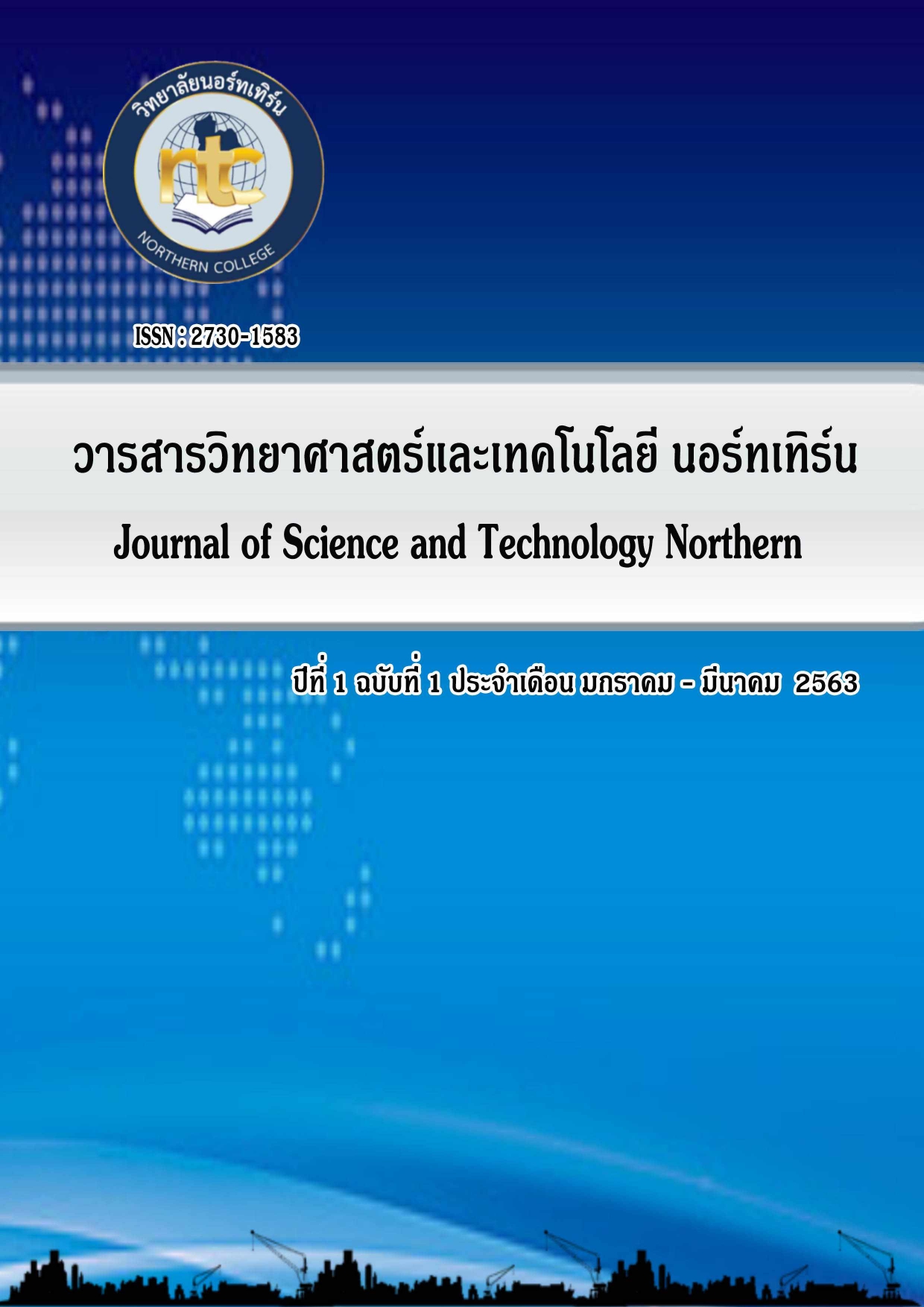แอฟพลิเคชันโภชนาการอาหารและการคำนวณการเผาผลาญแคลอรี่บน สมาร์ทโฟนระบบปฏิบัติการ Android
คำสำคัญ:
โภชนาการอาหาร, คำนวณการเผาผลาญแคลอรี่, บันทึกการรับประทานอาหาร, แบบทดสอบบทคัดย่อ
โครงการวิจัยระดับปริญญาตรีเรื่อง “แอฟพลิเคชันโภชนาการอาหาร และการคำนวณการเผาผลาญแคลอรี่บนสมาร์ทโฟนระบบปฏิบัติการ Android” มีวัตถุประสงค์เพื่อสร้างแอ ฟพลิเคชันโภชนาการอาหารและการคำนวณการเผาผลาญแคลอรี่บนสมาร์ทโฟนระบบปฏิบั ติการ Android เพื่อนำข้อมูลจำนวนแคลอรี่มาคำนวณการเผาผลาญโดยการเลือกประเภทกีฬาเพื่อให้ความรู้เกี่ยวกับโภชนาการอาหาร เพื่อนำมาคำนวณพลังงานที่ได้รับในแต่ละวัน เพื่อบันทึกการรับประทานอาหารในแต่ละวันแอฟพลิเคชันนี้พัฒนาขึ้นโดยใช้โปรแกรม An droid Studio ซึ่งเป็นโปรแกรมที่ใช้สร้างแอฟพลิเคชันบนระบบปฏิบัติการ Android โปร แกรม Photoshop CS6 เป็นโปรแกรมตกแต่งภาพให้มีประสิทธิภาพยิ่งขึ้นจากการสำรวจสอบถามความพึงพอใจของผู้ใช้จำนวน 20 คน โดยวัดระดับความพึงพอใจเต็ม 5 คะแนน ผ ลการประเมินที่มีความพึงพอใจมากสุดได้แก่ ความสะดวกการใช้งานไม่ซับซ้อน คิดเป็นค่าเฉลี่ย 4.35 แอฟพลิเคชันมีปุ่มฟังก์ชันเพียงพอ และเหมาะสมคิดเป็นค่าเฉลี่ย 4.3 และความถูกต้องของข้อมูลในการประมวลผลของระบบ คิดเป็นค่าเฉลี่ย 4.25 ซึ่งผลการประเมินทั้งห มดอยู่ในความพึงพอใจปานกลางถึงดี
เอกสารอ้างอิง
สำนักงานอุตสาหกรรมจังหวัดนครราชสีมา. (2561). รายงานความเคลื่อนไหวการลงทุนด้านอุตสาหกรรม. http://www.industry.go.th /nakhonratchasima/index.php.
Alison Couley. (2017). Concept Safety Review. North Yorkshire : Eggborough Power Station site.
Appil Ora. (2017). Hazard Identification of Chemical Mixing Plant through Hazop Study. International Journal of Advance Research and Development. 2(3), 79-84.
Bernhard. (2011). Identifying Software Hazards with a Modified CHAZOP.The First International Conference on Performance, Safety and Robustness in Complex Systems and Applications. 7-12.
Commonwealth of Australia (2018). HUMAN RELIABILITY ANALYSIS. https://www.nopsema.gov.au/resources/human-factors/human-reliability-analysis/.
Ehsan Saghatforoush. (2014). EXTENSION OF CONSTRUCTABILITY TO INCLUDE OPERATION AND MAINTENANCE FOR INFRASTRUCTURE PROJECTS. Thesis for the degree of Doctor of Philosophy. Science and Engineering Faculty Queensland University of Technology.
Elda Paja. (2015). The importance of teaching goal-oriented analysis techniques: an experience report. 1st International iStar Teaching Workshop. 2015(1), 37-42.
Gretchen A. (2018). Analysis of Safety Decision-Making Data Using Event Tree Analysis. http://lib.dr.iastate.edu/abe_eng_conf /356.
Gurujeet. (2018). Hazard and operability study (HAZOP). https://www.linkedin.com/pulse/hazard-operability-study-hazop-gurujeet-mohapatra.
Howard Lee. (2017). Failure mode and effects analysis drastically reduced potential risks in clinical trial conduct. Drug Design, Development and Therapy. 2017(11), 3035- 3043.
IYAN EKA MULIA. (2016). TSUNAMI SOURCE ESTIMATION AND WAVEFORM FORECAST USING COMPUTATIONAL INTELLIGENCE. Thesis for the degree of Doctor of Engineering. The Faculty of the Graduate School of Science and Engineering Kagoshima University.
John R. Taylor. (2013). Incorporating Human Error Analysis into Process Plant Safety Analysis. CHEMICAL ENGINEERING TRANSACTIONS. 2013(31), 301-306.
Jose Condor. (2011). A Comparative Analysis of Risk Assessment Methodologies for the Geologic Storage of Carbon Dioxide. 2011(4), 4036–4043.
Kouroush. (2015). Cause-Consequence Analysis for NASA’s Space Transportation System (STS)-Solid Rocket Booster (SRB). International Journal of Business and Management. 10(8), 23-28.
Miguel A. Trigos. (2016). Unmanned Helicopter Faults Diagnosis based on Petri Nets. I+D Revista de Investigaciones. 8(2), 91–103.
Muchamad. (2017). Hazard Identification and Risk Assessment of Health and Safety Approach JSA (Job Safety Analysis) in Plantation Company. IOP Conf. Series : Materials Science and Engineering. 2017(215), 1-10.
National Offshore Petroleum Safety and Environmental Management Authority. (2018). Critical task analysis. https://www. nopsema.gov.au/assets/ Information-papers/A500978.pdf.
Patrick J. Redmond. (2007). A SYSTEM OF SYSTEMS INTERFACE HAZARD ANALYSIS TECHNIQUE. Master’s Thesis, SCIENCE IN SOFTWARE ENGINEERING and SCIENCE IN SYSTEMS ENGINEERING NAVAL POSTGRADUATE SCHOOL.
Phayong. (2017). Job safety analysis and hazard identification for work accident prevention in para rubber wood sawmills in southern Thailand. Journal of Occupational Health. 2017(59), 542-551.
Philip McAleenan. (2015). CALCULATION OF THE NUMBER OF SYNERGISTIC HAZARDS AND RISKS ON CONSTRUCTION SITES THAT LIMITS THE EFFICACY OF RISK ASSESSMENT MATRICES. Proceedings of CIB W099 Benefitting Workers and Society through Inherently
Safe(r) Construction Belfast, Northern Ireland, 10-11 September. 390-397.
Rossella. (2015). Failure Mode, Effects and Criticality Analysis (FMECA) for medical devices: Does standardization foster improvements in the practice?. Procedia Manufacturing 3 (2015), 43–50.
SAS Institute Inc. (2015). Reliability and Survival Methods. Cary, NC : SAS Institute Inc.
Seyedeh. (2016). FRAGILITY ASSESSMENT AND RELIABILITY ANALYSIS OF TRANSMISSION LINES SUBJECTED TO CLIMATIC HAZARDS. Thesis for the degree of Doctor of Philosophy, Department of Civil Engineering and Applied Mechanics McGill University.
Stuart Burge. (2010). The Systems Engineering Tool Box. Warwickshire : Burge Hughes Walsh.
T. G. Jun. (2010). THINKING WITH SIMPLE DIAGRAMS IN HEALTHCARE SYSTEMS DESIGN. INTERNATIONAL DESIGN CONFERENCE - DESIGN 2010 Dubrovnik - Croatia, May 17-20, 1787-1794.
Vinay Dubey. (2016). Hazard Identification of cranes and their control measures. International Journal of Engineering Development and Research. 4(1), 504-509.
Yan Du. (2015). The role of hazard vulnerability assessments in disaster preparedness and prevention in China. Military Medical Research. 2015(2), 27.
Yi-nan Hu. (2016). Research on the Application of Fault Tree Analysis for Building Fire Safety of Hotels. Procedia Engineering 135 (2016), 524–530.
ดาวน์โหลด
เผยแพร่แล้ว
รูปแบบการอ้างอิง
ฉบับ
ประเภทบทความ
สัญญาอนุญาต
ลิขสิทธิ์ (c) 2020 วารสารวิทยาศาสตร์และเทคโนโลยีนอร์ทเทิร์น

อนุญาตภายใต้เงื่อนไข Creative Commons Attribution-NonCommercial-NoDerivatives 4.0 International License.







